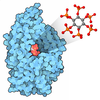+ Open data
Open data
- Basic information
Basic information
| Entry | Database: PDB / ID: 6zwo | |||||||||||||||||||||||||||
|---|---|---|---|---|---|---|---|---|---|---|---|---|---|---|---|---|---|---|---|---|---|---|---|---|---|---|---|---|
| Title | cryo-EM structure of human mTOR complex 2, focused on one half | |||||||||||||||||||||||||||
 Components Components |
| |||||||||||||||||||||||||||
 Keywords Keywords | TRANSFERASE / mTOR / Kinase / Complex / Inositol | |||||||||||||||||||||||||||
| Function / homology |  Function and homology information Function and homology informationRNA polymerase III type 2 promoter sequence-specific DNA binding / RNA polymerase III type 1 promoter sequence-specific DNA binding / positive regulation of cytoplasmic translational initiation / regulation of locomotor rhythm / T-helper 1 cell lineage commitment / positive regulation of pentose-phosphate shunt / regulation of phosphatidylinositol 3-kinase/protein kinase B signal transduction / positive regulation of wound healing, spreading of epidermal cells / TORC2 signaling / TORC2 complex ...RNA polymerase III type 2 promoter sequence-specific DNA binding / RNA polymerase III type 1 promoter sequence-specific DNA binding / positive regulation of cytoplasmic translational initiation / regulation of locomotor rhythm / T-helper 1 cell lineage commitment / positive regulation of pentose-phosphate shunt / regulation of phosphatidylinositol 3-kinase/protein kinase B signal transduction / positive regulation of wound healing, spreading of epidermal cells / TORC2 signaling / TORC2 complex / regulation of membrane permeability / cellular response to leucine starvation / negative regulation of lysosome organization / heart valve morphogenesis / TFIIIC-class transcription factor complex binding / TORC1 complex / voluntary musculoskeletal movement / positive regulation of transcription of nucleolar large rRNA by RNA polymerase I / regulation of cellular response to oxidative stress / calcineurin-NFAT signaling cascade / regulation of osteoclast differentiation / RNA polymerase III type 3 promoter sequence-specific DNA binding / positive regulation of keratinocyte migration / regulation of lysosome organization / phosphatidic acid binding / MTOR signalling / Amino acids regulate mTORC1 / cellular response to nutrient / cellular response to L-leucine / energy reserve metabolic process / regulation of autophagosome assembly / Energy dependent regulation of mTOR by LKB1-AMPK / TORC1 signaling / ruffle organization / negative regulation of Ras protein signal transduction / serine/threonine protein kinase complex / embryo development ending in birth or egg hatching / phosphatidylinositol-3,4-bisphosphate binding / cellular response to methionine / negative regulation of cell size / positive regulation of ubiquitin-dependent protein catabolic process / inositol hexakisphosphate binding / cellular response to osmotic stress / phosphatidylinositol-3,5-bisphosphate binding / anoikis / negative regulation of protein localization to nucleus / cardiac muscle cell development / negative regulation of calcineurin-NFAT signaling cascade / regulation of myelination / regulation of establishment of cell polarity / positive regulation of transcription by RNA polymerase III / negative regulation of macroautophagy / Macroautophagy / positive regulation of myotube differentiation / regulation of cell size / lipid biosynthetic process / positive regulation of actin filament polymerization / Constitutive Signaling by AKT1 E17K in Cancer / germ cell development / TOR signaling / phosphatidylinositol-3,4,5-trisphosphate binding / behavioral response to pain / mTORC1-mediated signalling / oligodendrocyte differentiation / positive regulation of oligodendrocyte differentiation / positive regulation of translational initiation / CD28 dependent PI3K/Akt signaling / positive regulation of TOR signaling / HSF1-dependent transactivation / regulation of macroautophagy / enzyme-substrate adaptor activity / response to amino acid / 'de novo' pyrimidine nucleobase biosynthetic process / positive regulation of epithelial to mesenchymal transition / heart morphogenesis / vascular endothelial cell response to laminar fluid shear stress / neuronal action potential / positive regulation of lipid biosynthetic process / cellular response to nutrient levels / regulation of cellular response to heat / positive regulation of lamellipodium assembly / cardiac muscle contraction / phagocytic vesicle / T cell costimulation / positive regulation of stress fiber assembly / phosphatidylinositol-4,5-bisphosphate binding / positive regulation of endothelial cell proliferation / cytoskeleton organization / substantia nigra development / endomembrane system / negative regulation of autophagy / negative regulation of insulin receptor signaling pathway / cellular response to amino acid starvation / cellular response to starvation / positive regulation of glycolytic process / positive regulation of translation / protein serine/threonine kinase activator activity / regulation of signal transduction by p53 class mediator / Regulation of PTEN gene transcription / VEGFR2 mediated vascular permeability Similarity search - Function | |||||||||||||||||||||||||||
| Biological species |  Homo sapiens (human) Homo sapiens (human) | |||||||||||||||||||||||||||
| Method | ELECTRON MICROSCOPY / single particle reconstruction / cryo EM / Resolution: 3 Å | |||||||||||||||||||||||||||
 Authors Authors | Scaiola, A. / Mangia, F. / Imseng, S. / Boehringer, D. / Ban, N. / Maier, T. | |||||||||||||||||||||||||||
| Funding support |  Switzerland, 3items Switzerland, 3items
| |||||||||||||||||||||||||||
 Citation Citation |  Journal: Sci Adv / Year: 2020 Journal: Sci Adv / Year: 2020Title: The 3.2-Å resolution structure of human mTORC2. Authors: Alain Scaiola / Francesca Mangia / Stefan Imseng / Daniel Boehringer / Karolin Berneiser / Mitsugu Shimobayashi / Edward Stuttfeld / Michael N Hall / Nenad Ban / Timm Maier /  Abstract: The protein kinase mammalian target of rapamycin (mTOR) is the central regulator of cell growth. Aberrant mTOR signaling is linked to cancer, diabetes, and neurological disorders. mTOR exerts its ...The protein kinase mammalian target of rapamycin (mTOR) is the central regulator of cell growth. Aberrant mTOR signaling is linked to cancer, diabetes, and neurological disorders. mTOR exerts its functions in two distinct multiprotein complexes, mTORC1 and mTORC2. Here, we report a 3.2-Å resolution cryo-EM reconstruction of mTORC2. It reveals entangled folds of the defining Rictor and the substrate-binding SIN1 subunits, identifies the carboxyl-terminal domain of Rictor as the source of the rapamycin insensitivity of mTORC2, and resolves mechanisms for mTORC2 regulation by complex destabilization. Two previously uncharacterized small-molecule binding sites are visualized, an inositol hexakisphosphate (InsP6) pocket in mTOR and an mTORC2-specific nucleotide binding site in Rictor, which also forms a zinc finger. Structural and biochemical analyses suggest that InsP6 and nucleotide binding do not control mTORC2 activity directly but rather have roles in folding or ternary interactions. These insights provide a firm basis for studying mTORC2 signaling and for developing mTORC2-specific inhibitors. | |||||||||||||||||||||||||||
| History |
|
- Structure visualization
Structure visualization
| Movie |
 Movie viewer Movie viewer |
|---|---|
| Structure viewer | Molecule:  Molmil Molmil Jmol/JSmol Jmol/JSmol |
- Downloads & links
Downloads & links
- Download
Download
| PDBx/mmCIF format |  6zwo.cif.gz 6zwo.cif.gz | 601.4 KB | Display |  PDBx/mmCIF format PDBx/mmCIF format |
|---|---|---|---|---|
| PDB format |  pdb6zwo.ent.gz pdb6zwo.ent.gz | 461 KB | Display |  PDB format PDB format |
| PDBx/mmJSON format |  6zwo.json.gz 6zwo.json.gz | Tree view |  PDBx/mmJSON format PDBx/mmJSON format | |
| Others |  Other downloads Other downloads |
-Validation report
| Summary document |  6zwo_validation.pdf.gz 6zwo_validation.pdf.gz | 1.7 MB | Display |  wwPDB validaton report wwPDB validaton report |
|---|---|---|---|---|
| Full document |  6zwo_full_validation.pdf.gz 6zwo_full_validation.pdf.gz | 1.7 MB | Display | |
| Data in XML |  6zwo_validation.xml.gz 6zwo_validation.xml.gz | 86.2 KB | Display | |
| Data in CIF |  6zwo_validation.cif.gz 6zwo_validation.cif.gz | 130.6 KB | Display | |
| Arichive directory |  https://data.pdbj.org/pub/pdb/validation_reports/zw/6zwo https://data.pdbj.org/pub/pdb/validation_reports/zw/6zwo ftp://data.pdbj.org/pub/pdb/validation_reports/zw/6zwo ftp://data.pdbj.org/pub/pdb/validation_reports/zw/6zwo | HTTPS FTP |
-Related structure data
| Related structure data |  11492MC  6zwmC C: citing same article ( M: map data used to model this data |
|---|---|
| Similar structure data |
- Links
Links
- Assembly
Assembly
| Deposited unit | 
|
|---|---|
| 1 |
|
- Components
Components
-Protein , 2 types, 2 molecules BF
| #1: Protein | Mass: 289257.969 Da / Num. of mol.: 1 Source method: isolated from a genetically manipulated source Source: (gene. exp.)  Homo sapiens (human) / Gene: MTOR, FRAP, FRAP1, FRAP2, RAFT1, RAPT1 / Production host: Homo sapiens (human) / Gene: MTOR, FRAP, FRAP1, FRAP2, RAFT1, RAPT1 / Production host:  References: UniProt: P42345, non-specific serine/threonine protein kinase |
|---|---|
| #3: Protein | Mass: 192472.922 Da / Num. of mol.: 1 Source method: isolated from a genetically manipulated source Source: (gene. exp.)  Homo sapiens (human) / Gene: RICTOR, KIAA1999 / Production host: Homo sapiens (human) / Gene: RICTOR, KIAA1999 / Production host:  |
-Target of rapamycin complex ... , 2 types, 2 molecules DH
| #2: Protein | Mass: 35910.090 Da / Num. of mol.: 1 Source method: isolated from a genetically manipulated source Source: (gene. exp.)  Homo sapiens (human) / Gene: MLST8, GBL, LST8 / Production host: Homo sapiens (human) / Gene: MLST8, GBL, LST8 / Production host:  |
|---|---|
| #4: Protein | Mass: 59075.551 Da / Num. of mol.: 1 Source method: isolated from a genetically manipulated source Source: (gene. exp.)  Homo sapiens (human) / Gene: MAPKAP1, MIP1, SIN1 / Production host: Homo sapiens (human) / Gene: MAPKAP1, MIP1, SIN1 / Production host:  |
-Non-polymers , 4 types, 5 molecules 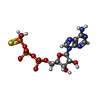
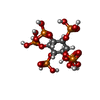





| #5: Chemical | | #6: Chemical | ChemComp-IHP / | #7: Chemical | ChemComp-ZN / | #8: Chemical | ChemComp-ACE / | |
|---|
-Details
| Has ligand of interest | Y |
|---|---|
| Has protein modification | N |
-Experimental details
-Experiment
| Experiment | Method: ELECTRON MICROSCOPY |
|---|---|
| EM experiment | Aggregation state: PARTICLE / 3D reconstruction method: single particle reconstruction |
- Sample preparation
Sample preparation
| Component | Name: human mTOR complex 2 / Type: COMPLEX / Entity ID: #1-#3 / Source: RECOMBINANT |
|---|---|
| Molecular weight | Value: 1.15 MDa / Experimental value: NO |
| Source (natural) | Organism:  Homo sapiens (human) Homo sapiens (human) |
| Source (recombinant) | Organism:  |
| Buffer solution | pH: 8.5 |
| Specimen | Conc.: 0.37 mg/ml / Embedding applied: NO / Shadowing applied: NO / Staining applied: NO / Vitrification applied: YES |
| Specimen support | Grid material: COPPER / Grid mesh size: 400 divisions/in. / Grid type: Quantifoil |
| Vitrification | Instrument: FEI VITROBOT MARK IV / Cryogen name: ETHANE-PROPANE / Humidity: 100 % / Chamber temperature: 277 K |
- Electron microscopy imaging
Electron microscopy imaging
| Experimental equipment |  Model: Titan Krios / Image courtesy: FEI Company |
|---|---|
| Microscopy | Model: FEI TITAN KRIOS |
| Electron gun | Electron source:  FIELD EMISSION GUN / Accelerating voltage: 300 kV / Illumination mode: FLOOD BEAM FIELD EMISSION GUN / Accelerating voltage: 300 kV / Illumination mode: FLOOD BEAM |
| Electron lens | Mode: BRIGHT FIELD / Nominal magnification: 130000 X / Calibrated magnification: 46300 X / C2 aperture diameter: 100 µm |
| Specimen holder | Cryogen: NITROGEN / Specimen holder model: FEI TITAN KRIOS AUTOGRID HOLDER |
| Image recording | Electron dose: 70 e/Å2 / Detector mode: COUNTING / Film or detector model: GATAN K2 SUMMIT (4k x 4k) |
- Processing
Processing
| EM software | Name: EPU / Version: 2 / Category: image acquisition |
|---|---|
| CTF correction | Type: PHASE FLIPPING AND AMPLITUDE CORRECTION |
| 3D reconstruction | Resolution: 3 Å / Resolution method: FSC 0.143 CUT-OFF / Num. of particles: 293038 / Symmetry type: POINT |
| Atomic model building | Space: REAL |
 Movie
Movie Controller
Controller









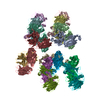
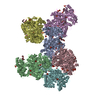

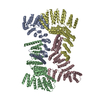


 PDBj
PDBj


